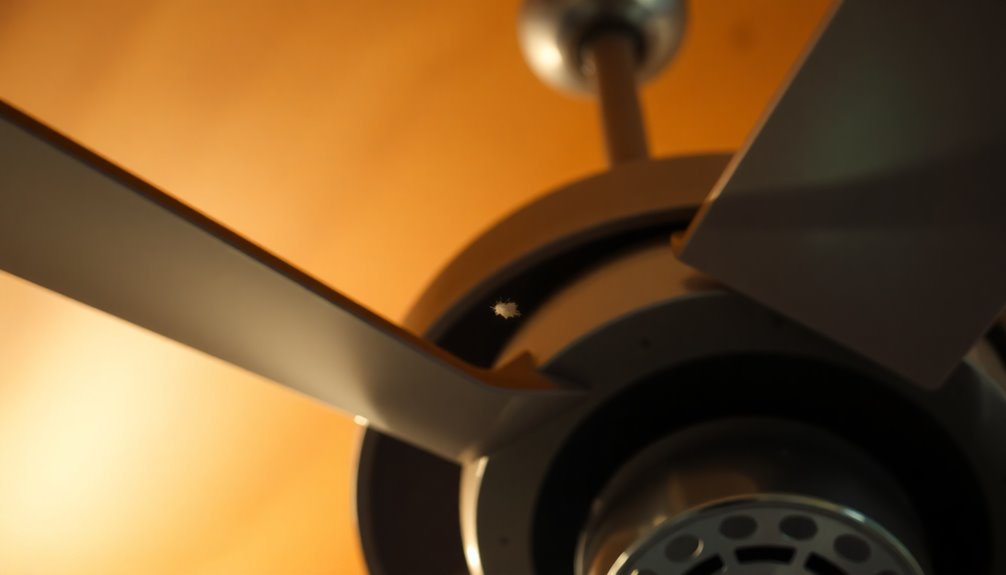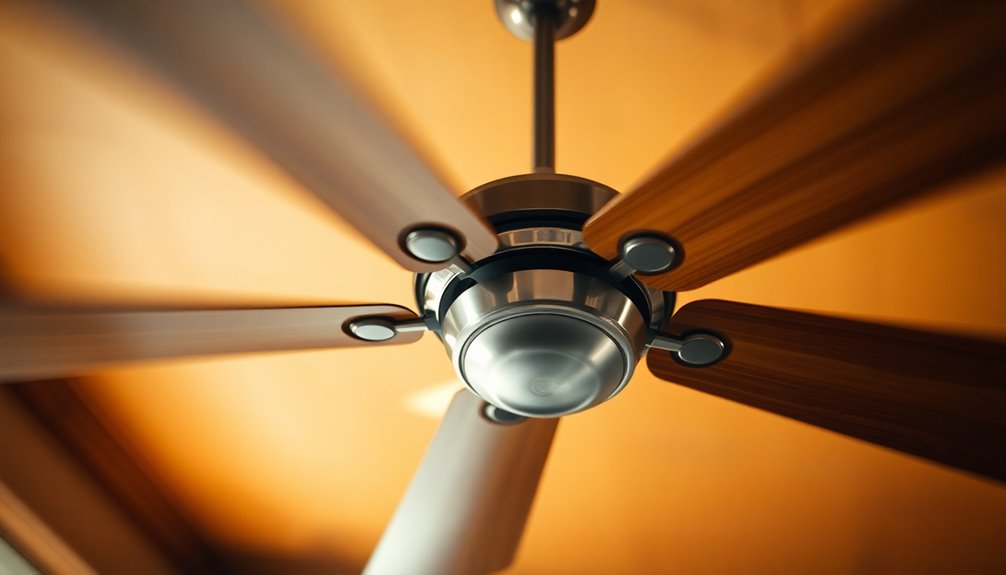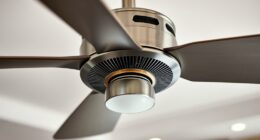Yes, a ceiling fan can potentially kill you, though it's rare. Every year, around 25 deaths and over 19,700 non-fatal injuries occur in the U.S. due to ceiling fans. Most accidents stem from improper installation, maintenance issues, or mechanical failures. Children and pets are especially at risk since they might not recognize the dangers. If your fan is wobbly or poorly installed, it's vital to address these problems immediately. Understanding the risks and safety measures can greatly reduce hazards in your home. There's more to explore on ensuring a safer fan experience and preventing accidents.
Key Takeaways
- Ceiling fans can cause serious injuries or fatalities, with approximately 25 deaths reported annually in the U.S. linked to ceiling fan accidents.
- Improper installation and maintenance are major factors that increase the risk of injuries, including dislodged fans and mechanical failures.
- Children and pets are particularly at risk due to their unawareness of ceiling fan dangers, heightening the likelihood of accidents.
- Regular inspections and proper installation height (8 to 10 feet) are crucial for enhancing safety and preventing potential hazards.
- Manufacturers and installers may face liability for defective products or improper installation, making safety a shared responsibility.
Ceiling Fan Safety Overview

When it comes to ceiling fan safety, understanding the risks is vital. While ceiling fans can enhance comfort in your home, improper installation can lead to significant fan injuries. Each year, over 19,700 non-fatal injuries linked to ceiling fans are reported in the U.S., often due to the fan being poorly mounted or not properly maintained.
A wobbly fan may seem harmless, but it can signal underlying issues that, if ignored, might escalate into more serious problems, like a ceiling fan fall. To minimize this risk, confirm your fan is securely mounted to a solid wooden joist, which dramatically reduces the chances of it falling, even if it wobbles.
Regular inspections are important for maintaining ceiling fan safety. By routinely checking for loose components or mechanical issues, you can address potential hazards before they result in accidents.
Additionally, installing your ceiling fan at the recommended height of 8 to 10 feet above the floor not only provides safe clearance but also contributes to reducing injury risks. Prioritizing these safety measures empowers you to enjoy your ceiling fan without worry. Furthermore, ensuring that your ceiling fan is properly maintained can greatly extend its lifespan and enhance overall safety.
Common Causes of Ceiling Fan Injuries

Ceiling fan injuries often stem from improper installation and maintenance, which can lead to dangerous situations. You mightn't realize that neglecting these aspects can result in the fan falling or blades detaching, putting you and your loved ones at risk.
Here are some common causes you should be aware of:
- Improper installation: Fans that are incorrectly mounted can easily become dislodged.
- Wobbly fan: Loud noises from a wobbly fan often indicate mechanical issues that need immediate attention.
- Lack of maintenance: Regular checks for wear and tear can prevent serious accidents.
- Children and pets: Vulnerable populations are at higher risk for ceiling fan injuries, as they may be unaware of the dangers.
- Non-fatal injuries: Over 19,700 non-fatal injuries related to ceiling fans are reported each year, emphasizing the need for vigilance.
Being proactive about installation and maintenance can greatly reduce the chances of accidents.
Stay alert to any signs of trouble, and never ignore a wobbly fan or unusual noises. Your safety depends on it!
Statistics on Ceiling Fan Accidents

Injuries from ceiling fans highlight a more serious issue that can lead to alarming statistics. Each year, approximately 25 deaths in the U.S. are linked to ceiling fan accidents, often occurring during cleaning or repair activities involving ladders.
While the risk of fatal incidents is low with proper installation and maintenance, over 19,700 non-fatal injuries are reported annually. Many of these accidents result from improper installation or maintenance, leading to serious injuries like lacerations, fractures, and concussions.
Children and pets are particularly vulnerable, as they mightn't be aware of potential dangers. A significant number of fatalities and severe injuries arise from fan falls due to improper mounting or material failure rather than direct contact with fan blades.
Misconceptions about ceiling fan dangers contribute to heightened fears, but understanding the actual risks can help alleviate concerns.
Liability for Ceiling Fan Injuries

Understanding liability for ceiling fan injuries is essential for anyone involved in their use, installation, or sale. When accidents happen, several parties may bear responsibility:
- Manufacturers: They can be held liable for defective ceiling fans or inadequate safety instructions.
- Installers: If injuries arise from improper installation, they may face legal consequences for not following safety guidelines.
- Property Owners: They've a duty to maintain a safe environment and can be held accountable for injuries due to neglect.
- Retailers: Selling faulty ceiling fans or providing misleading information about safety features can lead to liability.
- Victims: Those injured can pursue claims against manufacturers, installers, and property owners for compensation related to their injuries.
Each party has a role in ensuring the safety of ceiling fans. If you're involved in any capacity—whether as a consumer, installer, or property owner—it's vital to understand your potential liability.
Preventing Ceiling Fan Hazards

Preventing hazards associated with ceiling fans starts with proper installation and regular maintenance. Make sure your ceiling fans are installed with properly rated junction boxes to minimize the risk of accidents and injuries.
Regular maintenance is essential; tighten screws and check for loose components to prevent wobbling, which can lead to mechanical failures.
Keep a minimum clearance of 7 to 9 feet between the fan blades and the floor. This distance helps prevent accidental contact, especially in homes with children and pets.
Additionally, be aware of the fan direction settings. Operating the fan correctly for seasonal use can prevent overheating and possible electrical issues.
Consider installing safety cables for heavy ceiling fans. These cables add an extra layer of security, ensuring that the fan won't fall in case of bracket failure or improper mounting.
By focusing on these preventive measures—proper installation, routine maintenance, adequate clearance, and safety cables—you can greatly reduce the risks associated with ceiling fans.
Frequently Asked Questions
What Happens if a Ceiling Fan Falls on You?
If a ceiling fan falls on you, you could suffer serious injuries like lacerations, fractures, or concussions.
Weighing around 35 pounds, the fan's force upon impact is significant. You mightn't only face immediate pain but also long-term complications from such injuries.
It's vital to guarantee proper installation and regular inspections of ceiling fans to prevent these accidents.
Always stay alert, especially if you have children or pets around.
Safety first!
Is It Safe to Sleep With a Ceiling Fan on All Night?
You might find it amusing that most people sleep with a ceiling fan on, yet some worry about its safety.
Sleeping with a ceiling fan on all night is generally safe and can enhance your comfort. It helps circulate air and keeps you from overheating.
Just make certain it's well-installed and maintained. If you notice dry skin or irritation, try adjusting the fan's speed or direction to create a more pleasant sleeping environment.
What Happens if a Ceiling Fan Hits Your Head?
If a ceiling fan hits your head, the injury's severity depends on factors like the fan's weight and how far it falls. You might experience lacerations, bruises, or worse.
While it's rare for ceiling fans to fall, ensuring proper installation and regular maintenance can help prevent accidents.
If you ever notice anything amiss with your fan, it's best to address it quickly to keep yourself safe from potential injuries.
How Many People Get Hurt by Ceiling Fans?
Ceiling fans can cause quite a commotion! Each year, over 19,700 people get hurt by ceiling fans, often due to improper installation or malfunctioning mechanisms.
You might face lacerations, bruises, or even fractures, especially if you're not careful while cleaning or repairing. Kids and pets are particularly at risk, so it's essential to take safety precautions.
Always make sure your fan's up to standard to avoid any unfortunate accidents!
Conclusion
To sum up, while ceiling fans can enhance comfort, they're not without risks. Did you know that over 200 people are injured by ceiling fans each year in the U.S.? That's a startling number considering how often we rely on them. By staying aware of common hazards and following safety tips, you can enjoy the benefits of your ceiling fan without the worries. Always remember, a little precaution goes a long way in ensuring your safety at home!









